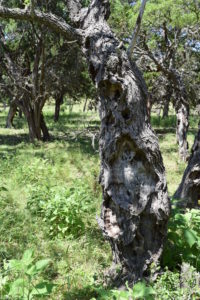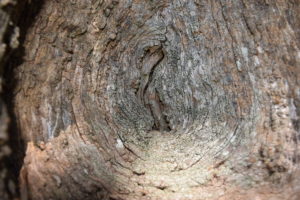COMMON NAME: Phomopsis Canker on Oak
SCIENTIFIC NAME: Phomopsis spp. (Sexual stage: Diaporthe spp.)
DISEASE DESCRIPTION: Phomopsis is a common pathogen and may be found on many more woody species of trees, shrubs and even vines than just oaks. Since stress is often involved with the incidence and severity of Phompsis canker, the disease will increase with periods of drought, episodes of site distrubances, and other environmental issues that affect the health of a tree.
DISEASE SYMPTOMS: Large, abnormal, tumor-like swelling outgrowths on branches and trunks of oak trees. Leaf wilting, blight of young shoots, and darken-sunken areas of the stem with possible sap or resin flow are also common.
BIOLOGY: Phomopsis is an ascomycete fungal pathogen that infects an oak tree by an open wound. Phomopsis may also gain entry though young buds and progress down the stem. Open wounds can come from physical or mechanical injury, freeze injury, excess pruning, or insect feeding. Although there are no known insect vectors for Phomopsis, a feeding or tunneling insect can create an open wound for Phomopsis to enter. Phomopsis develops best in the springtime and is spread by splashing rain. Wet, high moisture, shady, and cool temperatures (59°F-75°F) are environmental conditions that favor the development of Phomopsis canker. Once Phomopsis has established growth inside an oak tree, it disperses cream-colored spores produced on small black fungal “fruiting bodies”. These tiny structures are prodigious sources of spores, which are released and then blown to nearby stems where new infections begin.
 MANAGEMENT: Proper diagnosis is always the first step for managing a tree disease like Phomopsis canker. Once Phomopsis infection is confirmed, begin by pruning out and discarding infected branches. Sanitize pruning tools before and after pruning on diseased trees and their tissues. Avoid pruning in wet conditions as water increases the spread of Phomopsis. Fungicides can be used on newly developing shoots but only as a preventative maintenance. Drought stress and lack of nutrients of the oak tree can increase Phomopsis infection. Once infection is established it can be very difficult to eradicate as fungal spores are produced throughout the growing season.
MANAGEMENT: Proper diagnosis is always the first step for managing a tree disease like Phomopsis canker. Once Phomopsis infection is confirmed, begin by pruning out and discarding infected branches. Sanitize pruning tools before and after pruning on diseased trees and their tissues. Avoid pruning in wet conditions as water increases the spread of Phomopsis. Fungicides can be used on newly developing shoots but only as a preventative maintenance. Drought stress and lack of nutrients of the oak tree can increase Phomopsis infection. Once infection is established it can be very difficult to eradicate as fungal spores are produced throughout the growing season.
REFERENCES LINKS:
https://plantdiseasehandbook.tamu.edu/landscaping/trees/oak/
This site briefly described pathogen associated with Oaks.
https://ag.umass.edu/landscape/fact-sheets/phomopsis-canker
This site gave a great deal of information about Phomopsis canker, most of my information came from this site.
https://www.canr.msu.edu/news/weather_conditions_are_ideal_for_phomopsis_diseases_2006 This site gave ideal weather conditions favoring Phomopsis.
This factsheet is authored by
Aaron W. Essary
B.S. in Plant Biology
Pursing a Master’s of Science in Horticulture, Enology
Factsheet information for the plant health issues represented by the images on the 2020 TPDDL calendar were written by graduate students enrolled in the Department of Plant Pathology & Microbiology DR. DAVID APPEL’s Graduate level Introductory Plant Pathology course (PLPA601) in the 2019 Fall semester. This exercise provides an opportunity for a high impact learning activity where the students are tasked with producing an informational output directed to the general public. This activity provides an opportunity for the students to write and produce a (hopefully) useful product to communicate information on plant health issues to the public.
